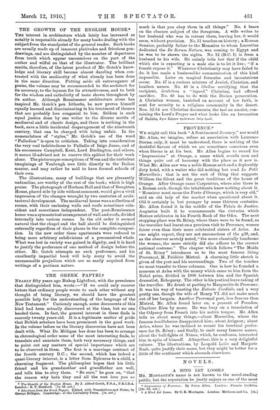THE GROWTH OF THE ENGLISH HOUSE.* THE interest in architecture
which lately has increased so notably is responsible already for many books dealing with the subject from the standpoint of the general reader. Such books are usually made up of innocent platitudes and frivolous pen- drawings, and are distinguished by the number of departures from truth which appear unconscious on the part of the author and wilful on that of the illustrator. The brilliant merits, therefore, of the latest product of Mr. Gotch's know- ledge and literary skill become almost dazzling when con- trasted with the mediocrity of what already has been done in the same direction. Putting aside all extravagance of praise, the volume may be recommended to the architect for its accuracy, to the layman for its attractiveness, and to both for the wisdom and catholicity of taste shown throughout by its author. Although Renaissance architecture alone has inspired Mr. Gotch's pen hitherto, he now proves himself equally learned and discriminating in his treatment of themes that are probably less congenial to him. Seldom is such equal justice done by one writer to the diverse merits of mediaeval and of classic design, and there is nothing in the book, save a little incidental disparagement of the nineteenth century, that can be charged with being unfair. In the nomenclature of " styles," Mr. Gotch's use of the word "Palladian" is open to criticism. Taking into consideration the very real indebtedness to Palladio of Inigo Jones, and of his successors Campbell, Kent, Lord Burlington, and others, it seems ill-advised not to reserve this epithet for their work alone. The picturesque conceptions of Wren and the turbulent imaginings of Vanbrugh owe little directly to the Italian master, and may rather be said to have formed schools of their own.
The illustrations, many of buildings that are pleasantly unfamiliar, are worthy of the rest of the book; which is high praise. The photograph of Horha.m Hall and that of Boughton House, placed side by side without comment, would give a vivid impression of the changes wrought by two centuries of archi- tectural development. The mediaeval house was a collection of rooms, with their enclosing walls and roofs sometimes coin- cident and sometimes independent. The post-Renaissance house was .a symmetrical arrangement of wall and roofs, divided internally into various rooms. In the old order it seemed natural that the chapel and the hall should be distinguished externally regardless of their places in the complete composi- tion. In the new order these apartments were reduced to being mere arbitrary subdivisions of a preconceived whole. What was lost in variety was gained in dignity, and it is hard to justify the preference of one method of design before the other. Mr. Gotch attempts no such preference, and his excellently impartial book will help many to avoid the unreasonable prejudices which are so easily acquired from writings of a partisan nature.














































 Previous page
Previous page